We’re at a really exciting time where the number of crewed vehicles going to the international space station will go from just one to three!. The Soyuz’s 8 year monopoly for getting humans to the ISS is coming to an end. So today we’re going to take a deep dive on the two new spaceships that will be responsible for taking humans to and from the International Space Station from the United States. We’ll compare the Boeing Starliner riding an Atlas V rocket to SpaceX’s Crew Dragon on their Falcon 9 Rocket.
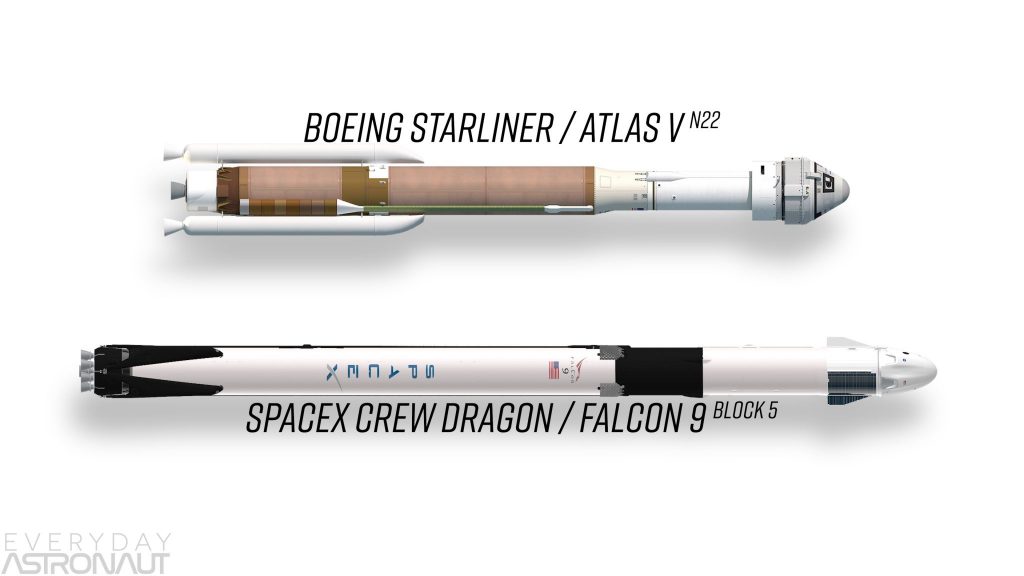
And to see how we’ve progressed in the world of human spaceflight, we’ll also compare all these systems along side Russia’s Soyuz capsule and the United State’s retired Space Shuttle in a side by side comparison. We’ll look at the designs, the rockets they’ll ride, dimensions, cost, safety considerations, and any other unique features that each vehicle offers.
Considering I’ve been up close and personal with SpaceX’s Crew Dragon Capsule, and Boeing’s Starliner, I’ve got some good insight on some of these vehicles, so let’s get started!
The International Space Station is still one the greatest feats of human engineering. After all, it’s a football field sized floating laboratory traveling 10 times faster than a bullet, circling the Earth every 90 minutes. It’s taken 33 launches to put all of its pieces into orbit and has been home to over 230 people from almost 20 countries.
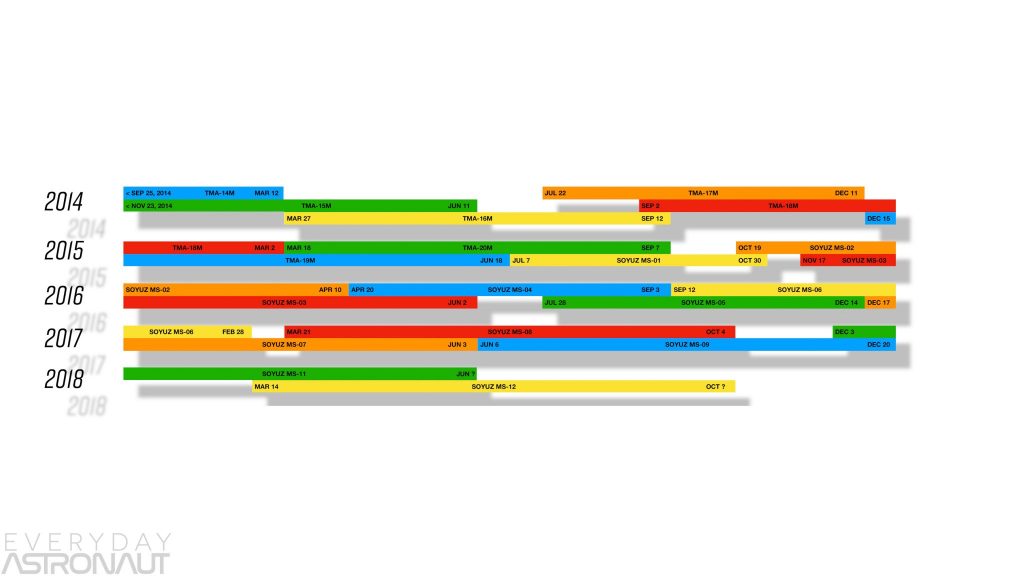
The ISS typically has 6 astronauts onboard. Crews are sent in groups of 3 and usually reside at the station for 6 months. There is typically a 3 month overlap for the existing crew and the newly arriving crew. Since the Space Shuttle program ended in 2011, there’s only been a single ride to the ISS. Russia’s Soyuz vehicle.
But we’re coming up on a really exciting time as the United States prepares to send astronauts to the International Space Station from US soil on two brand new spaceships! And what’s super exciting, is NASA has hired private companies to do the development and operations in a new program called the commercial crew program.
The two companies that won contracts are SpaceX and Boeing. I’m not really going to get into how the commercial crew program got started or has progressed in today’s video, I mostly want to talk about the hardware. Each company has a unique approach to how they’ll get crew to the station, so let’s dive into each one and then we’ll compare them to the Soyuz capsule as well as the Space Shuttle to see how much has changed since the ISS was born.
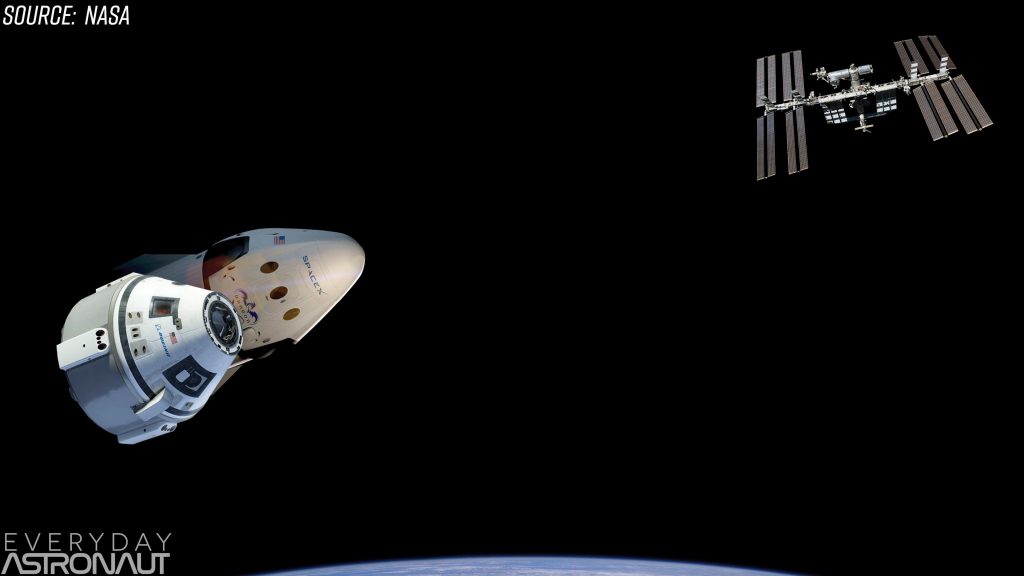
Starting off with Boeing and their Starliner. Boeing started designing the Starliner, originally known as the CST-100, in 2010 after winning a contract from NASA for the CCDev program. The starliner is a traditional truncated cone capsule design, much like previous spacecraft from the United States. It can carry up to 7 astronauts at a time, although NASA won’t use more than 4 seats at a time.

The Starliner will be the first orbital capsule to land on solid ground in the United States. This is similar to how the Soyuz capsule lands, and also how Blue Origin’s Suborbital New Shepard capsule lands. There are five landing sites proposed in the Western United States but the two prime sites will be the U.S. Army’s White Sands Missile Range in New Mexico and the Army’s Dugway Proving Ground in Utah.
Starliner will land using parachutes and a set of large airbags. A pair of drogue chutes are deployed at about 9 km in altitude, followed by a trio of main chutes at 3.6 km. At 1.5 km in altitude, the heat shield is ditched and the 6 airbags are inflated. These airbags serve a dual purpose. In nominal use cases, the airbags will soften the landing when landing on land, and in off-nominal cases, like an abort or an emergency reentry, the airbags offer buoyancy and balance for water landings.
Touching down on land will allow the Starliner an easy path to refurbishment and reusability. Boeing is hoping to be able to turn one around in just 6 months and reuse them up to 10 times! That’s definitely a good thing. Since the crew will land on solid ground, recovery of crew is quite different than a splashdown. On the edge of the landing zone there’ll be a Mobile Data Tracking Vehicle or MDTV as well as a Mobile Landing Control Center or MLCC as well as a host of recovery vehicles waiting to pounce.


Once touchdown is confirmed, a small army of vehicles will race there way across the desert. I picture this pretty much being a real life Mad Max. PLEASE BOEING SEND US VIDEOS OF THIS.
Upon arrival, a ground crew will check and stabilize the hydrazine fuels and then ground the vehicle for static electricity. After that, an HVAC truck will roll up and start to cool the spacecraft, including the crew and the fuels. Next up a Mobile Landing Platform will pull up with stairs and begin to evacuate the crew. Boeing has to pull crew out within one hour and cargo within two. The person who extracts the crew is actually a member of Boeing’s Fire and Rescue team, which I think is cool.
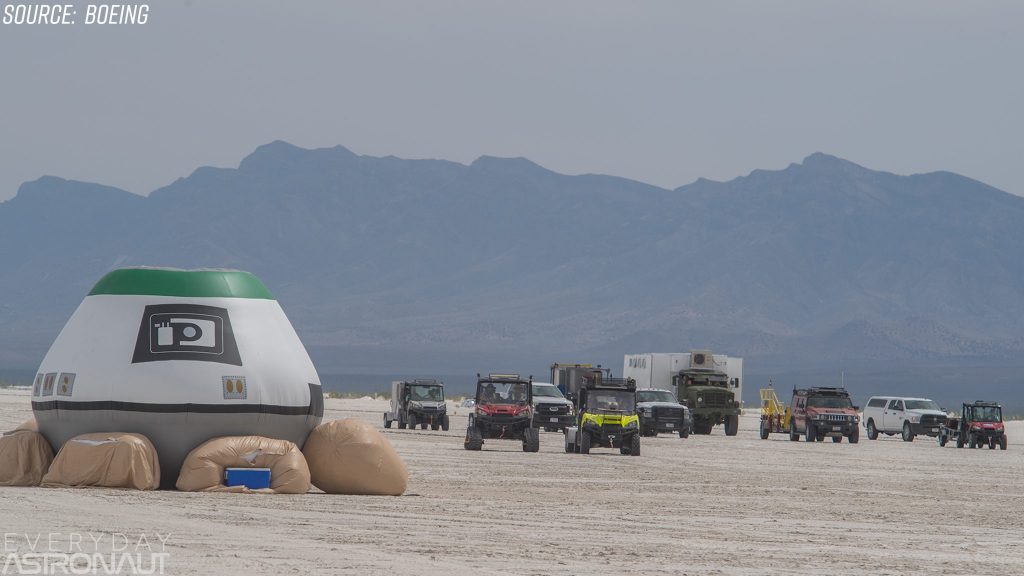
The crew is taken out and sent over to a truck for medical check ups then whisked away on a NASA helicopter. Sweet! Eventually the capsule itself is loaded up with a small crane truck and taken back to begin refurbishment. The cockpit of Starliner takes a fairly conservative and familiar approach. Although it’s a lot less cluttery than the Space Shuttle’s cockpit, it still features familiar and traditional controls, buttons and non-touch screens. In most use cases, the commander and pilot won’t really need to use the controls as the Starliner is designed to be fully autonomous.
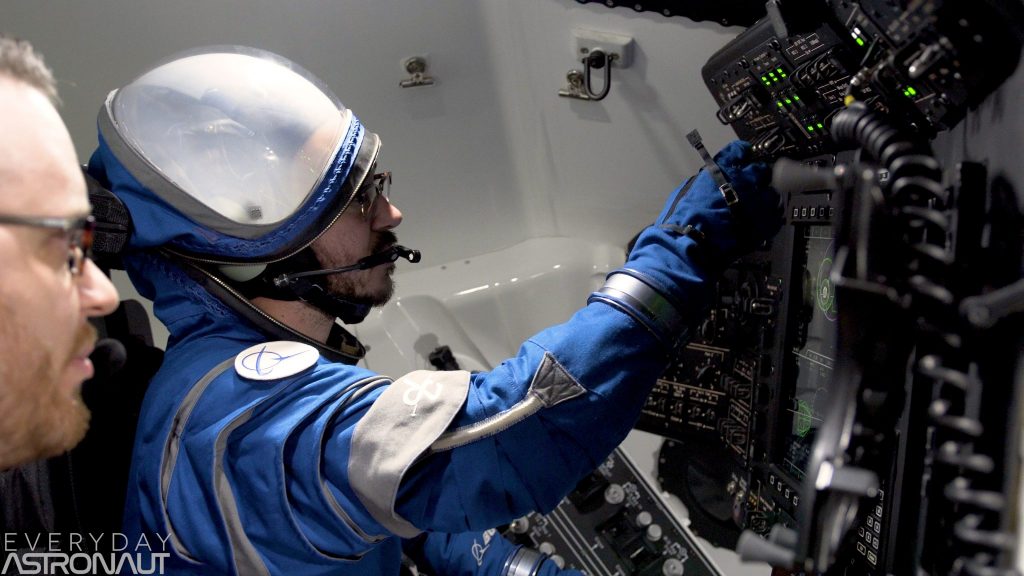
The Starliner will dock to the ISS and not berth. Docking is where the vehicle actually does all the final maneuvering until it connects itself with the docking port. Dragon 1 and Cygnus vehicles currently berth to the station, meaning they park and then are grappled into the station via the Canadarm. Astronauts get in and out of the side hatch when on Earth but when docked, they will crawl through the top port that connects to the international docking adapter on the ISS.
Initially getting into and out of the Starliner is admittedly a bit cumbersome. Astronauts need to shimmy into their seats, laying on their back. When looking down from the top of the capsule, the astronauts will sit in rows of 3 and 4.
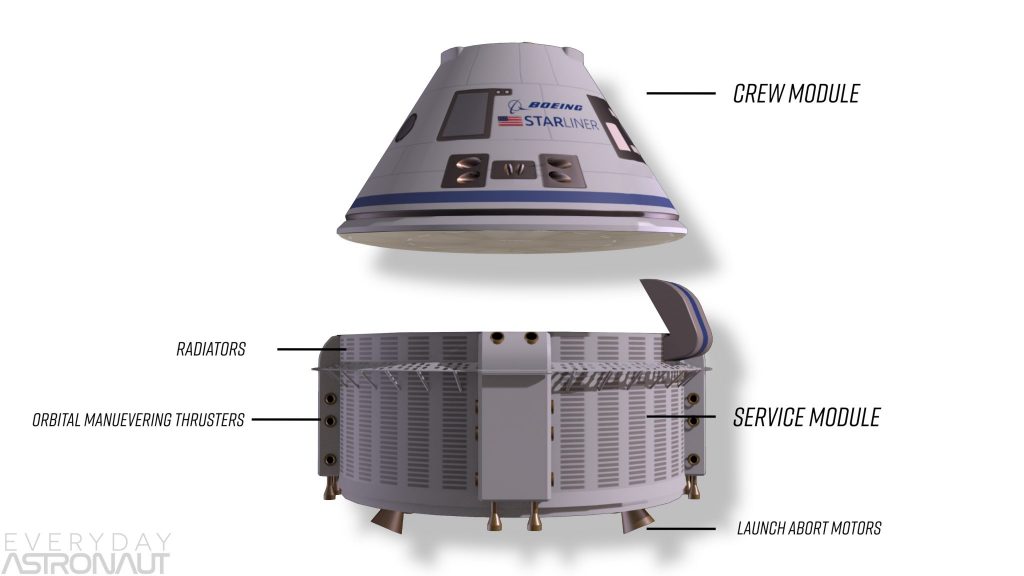
The spacecraft are two main sections, the crew module, and the service module. The crew module is…. uh exactly what you think it is, where the crew goes. It’s also the part that survives reentry. The service module houses propellant tanks for orbital maneuvering, the orbital maneuvering thrusters, the launch abort motors, which are on the bottom in a pusher configuration, solar panels on the bottom, and radiators on the sides.
The abort motors are 4 Aerojet Rocketdyne RS-88 Bantams modified to run on hypergolic fuels to function as a launch abort motor. The first uncrewed test flight, OFT-1 will fly with the qualification test motors, but they will be inactive since there will be no crew onboard. In the event of an issue with the booster or a rapid unscheduled disassembly, These abort motors would be used up until a few minutes into the flight, after which time the vehicle would just use the maneuvering thrusters. The Starliner offers a full envelope abort window, meaning the astronauts can abort at any time and remain safe.
Boeing designed the Starliner to be able to ride on a variety of rockets including the Atlas V, the Delta IV, the Vulcan and the Falcon 9. They wound up selecting United Launch Alliance’s Atlas V for now, and eventually, ULA’s upcoming Vulcan rocket will likely fly Starliner. The exact Atlas V they selected is an N22.
A quick reminder of the numbers, the first part of the name represents the fairing size, the options being 4, 5 or N for none. The middle number is the amount of strap on rocket boosters and can range between 0 and 5. The last number is the number of RL-10 engines on the Centaur upper stage. The centaur can have 1 or 2 RL-10s.
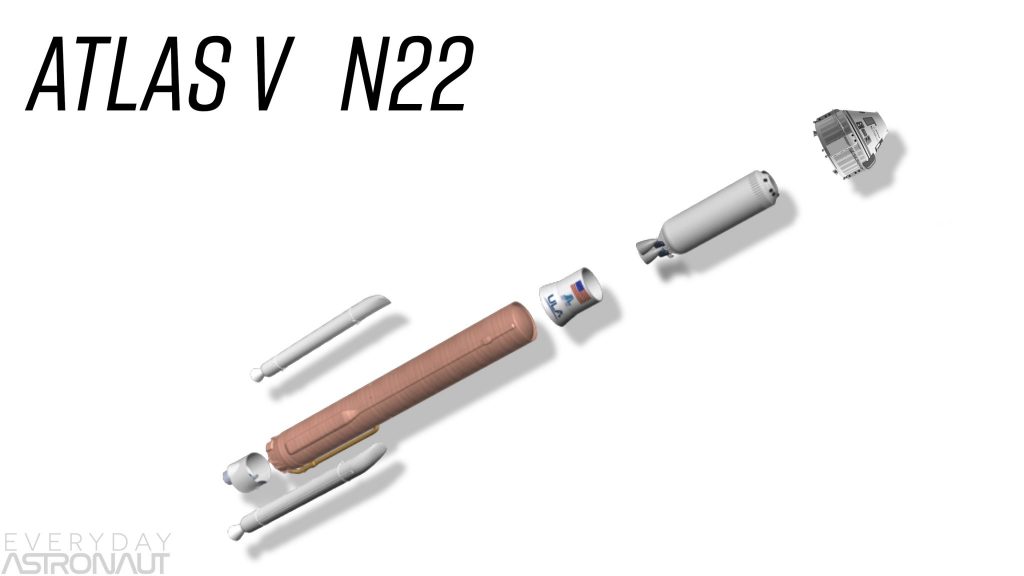
So putting this together, the Atlas V that will launch the Starliner will have no fairing, since it has the Starliner on top, it will have 2 solid rocket boosters and dual RL-10 engines on the upper stage.
When Starliner launches, it will be the first time ULA’s actually used a dual RL-10 centaur upper stage on the Atlas V, however, the dual engine Centaur has been flying since 1962 and flew on the Atlas III as recently as 2005! So it’s definitely not anything new. So why are Boeing and ULA using a dual engine centaur when the Starliner is relatively light? The RL-10 engine is crazy efficient, but one thing it isn’t is powerful.
In order to allow enough time for a standard single engine to push the upper stage and payload into orbit velocities without reentering the atmosphere, the first stage of the Atlas V usually lofts it to an extra high altitude, allowing more time for the upper stage to do its circularization burn. This works great for standard payloads, but in the case of an abort, this trajectory would actually result in the Starliner coming back in too steep, generating crazy high, unsurvivable G forces when as it hits the atmosphere.
So in order to maintain a nice, safe, shallow profile for the fragile and precious humans onboard, the upper stage needed more oomph, and the solution was the dual engine centaur! If you need more info on this unique engineering solution, Scott Manley did an excellent video going more into it.
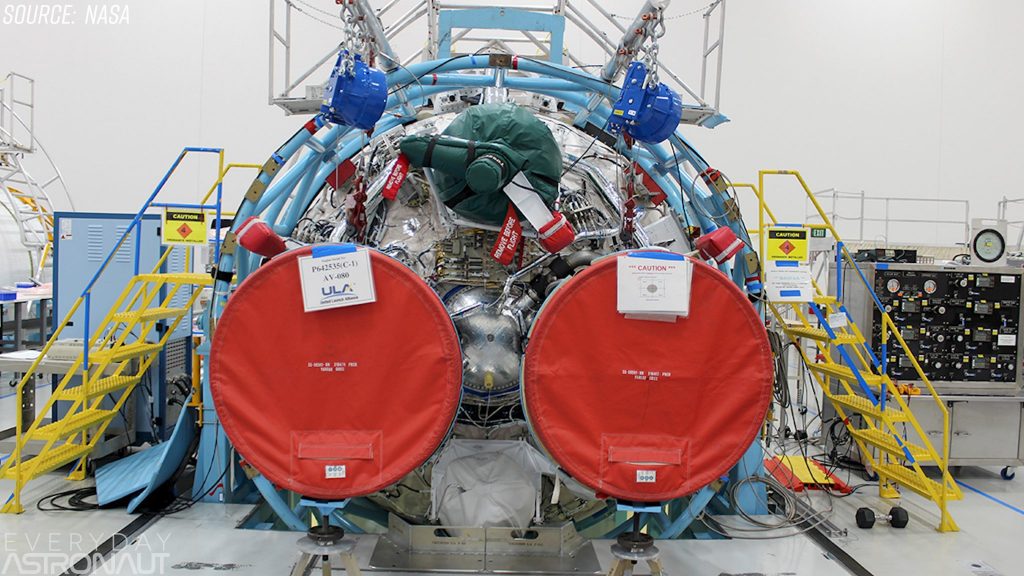
Boeing and ULA will also be running a secondary flight computer that will be running in parallel to the primary flight computer on the centaur upper stage. It will catch any errors in the flight plan faster than human reaction time, shutdown the engines and trigger an abort.
Another design consideration is due to the blunt nose of the Starliner you’ll see these little lattice structures. The Starliner was designed to be as stable as possible for reentry, which means a short and stout design. The lattice structure helps diffuse the airflow over the vehicle, helping to make sure there are no shock waves or any inadvertent pressure areas on the lower portion of the vehicle on the scent. Especially since the rocket actually tapers down to the skinny centaur upper stage. They also added an aerodynamic skirt to ensure smooth airflow.
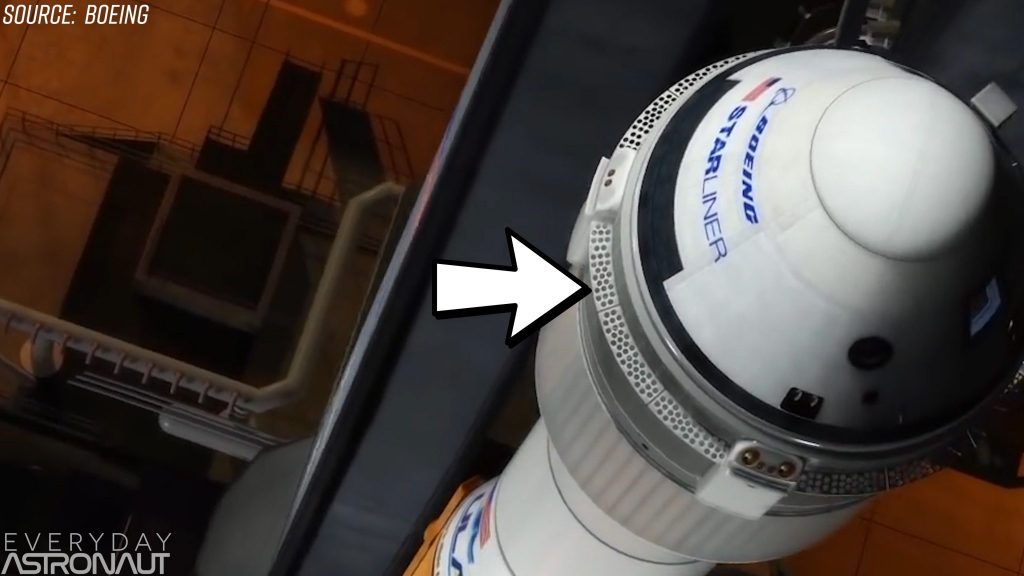
Despite the Apollo Spacecraft being a similar shape, the Saturn V it rode on top of, kind of wedding caked out, tapering wider and wider and therefore didn’t have those design considerations. Starliner Astronauts will take off from ULA’s launch pad SLC-41 launch pad at Cape Canaveral Air Force Station in Florida. The pad has already been fitted with the crew access arm in preparation for the first crew launches.
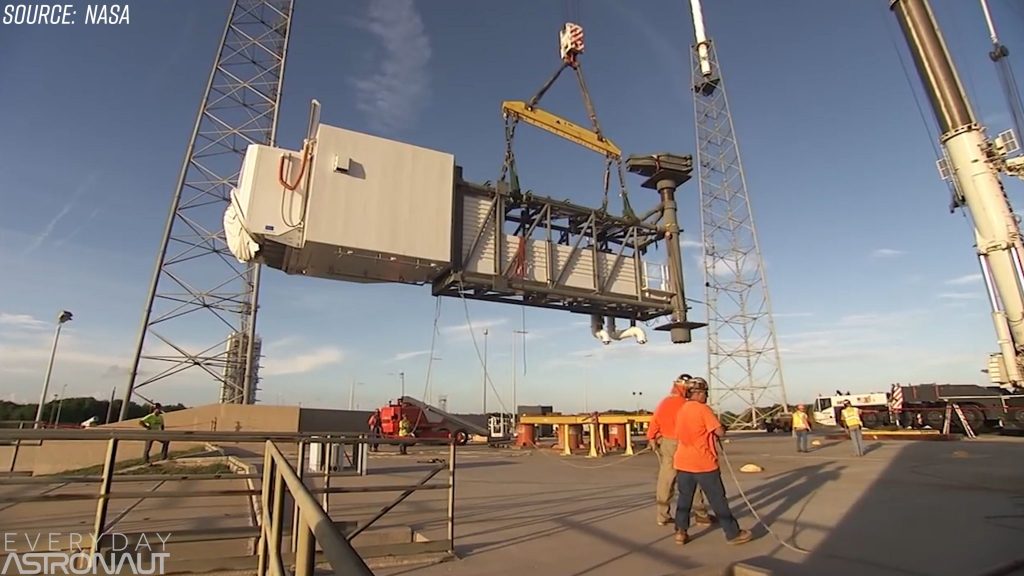
This will be the first time humans have launched from this particular launch pad, which is awesome and also the first time a human has launched from Cape Canaveral Air Force Station since Apollo 7 in 1968. We’ll get into the dimensions, designs, prices, and more when we do a side by side comparison of all vehicles.
Now onto the other new spaceship, SpaceX’s Crew Dragon or Dragon 2. Dragon two is the follow up to SpaceX’s very successful Dragon capsule that has flown cargo to and from the ISS since 2012. The Dragon capsule was originally called DragonRider when it was initially proposed to NASA for the CCDev program. SpaceX was not selected for the first round, perhaps because the Dragon capsule had noses… but SpaceX was selected during the second round of contracts.
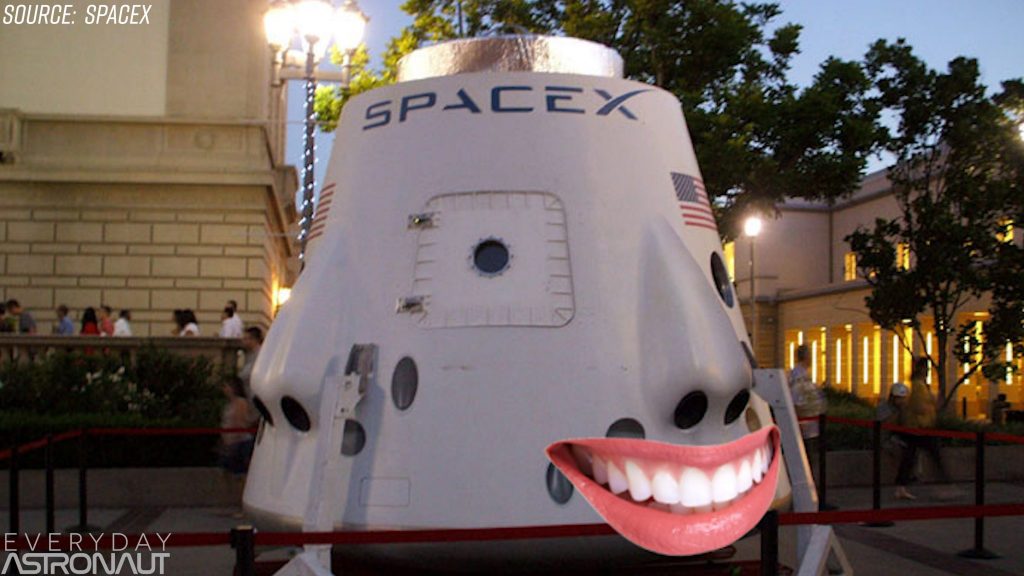
This original DragonRider capsule was essentially just a crew rated version of their Dragon Capsule, which at the time was getting ready for its first test flight to orbit and was already on contract to resupply the ISS which it would later do in 2012. In 2014, SpaceX revealed the updated version of the Dragon capsule which would carry astronauts at their HQ in Hawthorne.
The Dragon 2 was a massive redesign of the original Dragon Capsule including seating for up to 7 astronauts, although again, NASA won’t be using more than 4 at a time for the Commercial Crew Program. Dragon 2 was originally planning to also touch down back on land using the abort motors, assuming they weren’t used for an abort to come to a nice soft touchdown anywhere. However, due to a few reasons, SpaceX ditched propulsive landings and will do a parachute recovery and splashdown in the ocean, much like the current Dragon Capsule. Update: Due to concerns about G-forces upon splashdown, SpaceX was required to change the angle of the seats. This change meant SpaceX could no longer fit 7 seats, causing them to reduce the number to 4.
If you want to know more about why SpaceX cancelled propulsively landing their Dragon Capsule, I’ve already got a video all about it here.
The Crew Dragon’s primary landing zone is the Atlantic ocean, which is different from the current Dragon Capsule which has been splashing down in the Pacific Ocean since its first launch and recovery in 2010. SpaceX also filed to have the Gulf of Mexico be a contingency landing site too, which would be a first I believe.

SpaceX will have a pair of ships named Go Searcher and Go Navigator that will be in charge of crew recoveries. Go Searcher features a hoist capable of lifting the Dragon capsule onto the deck and then offloading the crew. There’s also communication relays and a helicopter landing pad to get the crew home after splashdown.
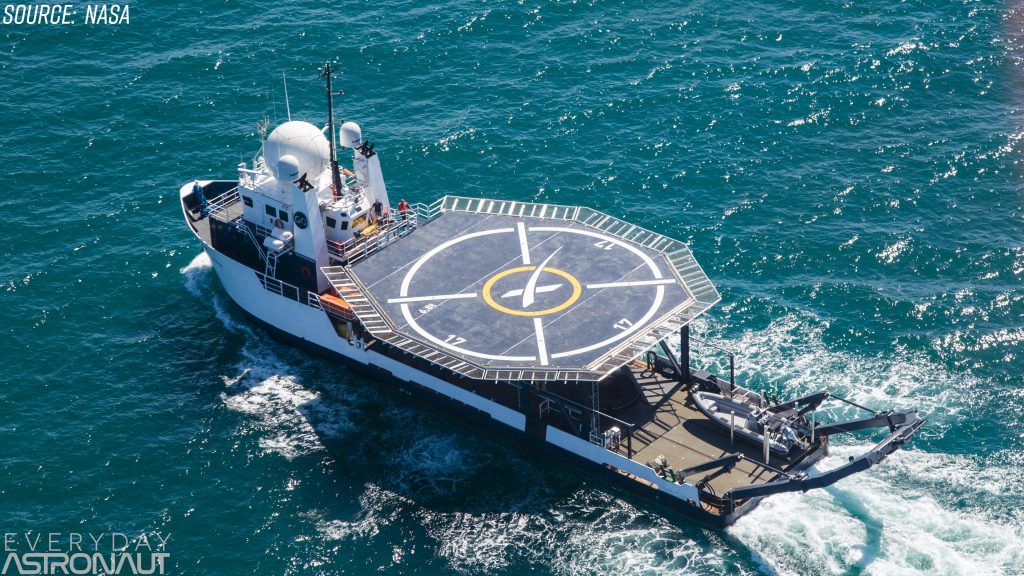
Go Searcher has been part of SpaceX’s fleet for a while, aiding in the recovery efforts of Falcon 9 drone ship landings as well as Dragon 1 recoveries.
Despite the ocean landings, SpaceX has refurbishment and reuse plans for Dragon 2, although not quite like you may be thinking. Refurbished Dragon 2’s won’t carry humans again but may eventually be used to carry cargo for CRS-2 missions. SpaceX has experience refurbishing splash downed Dragon Capsules, and has reflown 5 Dragon capsules to date, although according to Elon Musk in 2017, he mentioned it’s almost as expensive to refurbish the splashdowned Dragons as it is to build new ones. But I’m sure since then they’ve implemented streamlined processes and have made the efforts worth while.
The design of the Crew Dragon capsule is extremely minimalistic. It’s easy to see that the design was influenced by Elon who likes things simple. This interior is like the Tesla Model 3 of spaceships compared to Knight Rider’s car, Kitt. Some unique features of the interior are touchscreens and movable chairs. When Dragon 2 was first revealed, Elon sat in a seat and pulled the screen down to him, that’s now reversed as the screens are stationary and the seats move up to them.
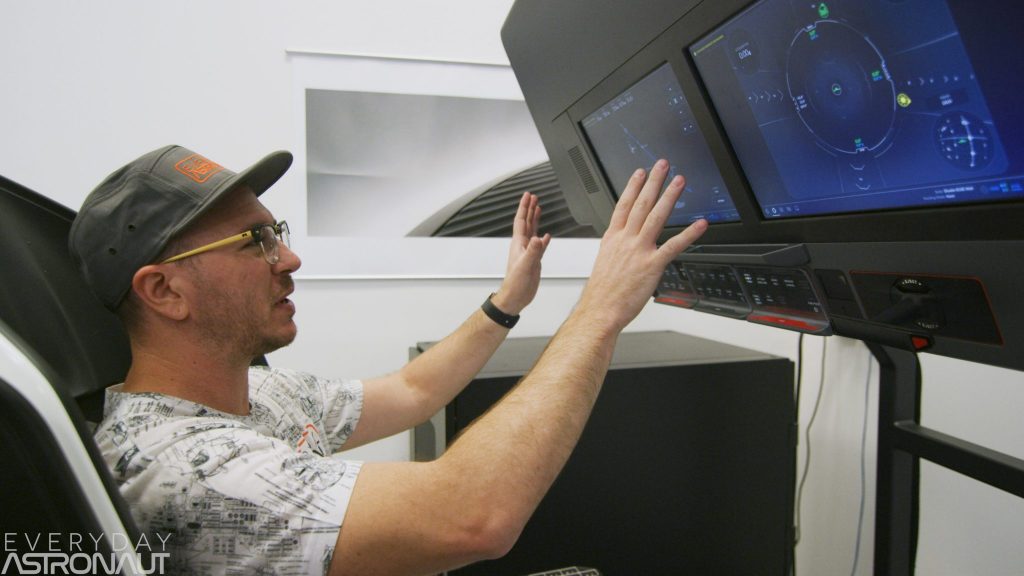
Again, just like Starliner, the Dragon 2 is designed to be fully autonomous with manual overrides really only there as contingencies. But the Dragon 2 does something the old Dragon 1 couldn’t do, and that’s, dock.
Getting into the Crew Dragon capsule is done via the side hatch. Once you poke your head in, it’s very spacious and minimalistic. It’s very easy to plop into a seat and get comfy. I really think this layout makes sense.
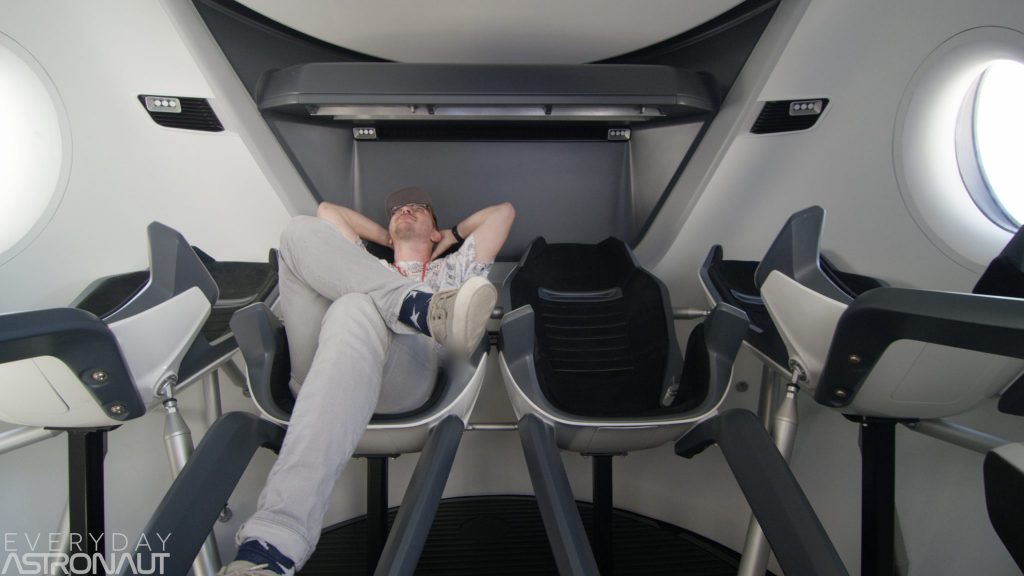
Like the Starliner, the Dragon 2 is actually two sections as well. There’s the Crew Module and the Trunk. The crew module is again, the part that holds the humans, but it also has the Super Draco abort motors integrated onto it. Since this portion of the spacecraft is recovered, the Super Draco motors are also recovered… yay.

Just like the Starliner, the Super Draco motors run on hypergolic propellants and offer a full envelope escape window as well.
The trunk is an unpressurized section of the spacecraft, just like it is on Dragon 1. This allows for the ability to take up larger components that wouldn’t fit through the docking port, or items that are installed on the outside of the station. Items installed in the trunk are retrieved via the Canadarm 2 or another arm named Dextre. The trunk of the Dragon 2 offers a unique layout with stationary solar panels covering one side of the vehicle and the radiator panels on the other side. The old Dragon 1 had extending solar panels.
The trunk also has some fins on it to help stabilize the vehicle in the event of an abort. I already did a video all about this, so if you want to learn more about the fins on Dragon’s and why they matter during an abort, check this out.
The trunk is detached prior to reentry and burns up due to a lack of heat shield. This allows for disposal of some on station items as well. A very fiery garbage service.
The Dragon 2 is designed to exclusively fly on the Falcon 9 although there were plans for it to fly on Falcon Heavy at one point, but SpaceX no longer plans to human certify Falcon Heavy and instead is focusing on Starship. In order for the Falcon 9 to be crew rated, NASA required a design freeze of their Block 5 variant since SpaceX tends to upgrade their vehicles so frequently, sometimes introducing unintended consequences…
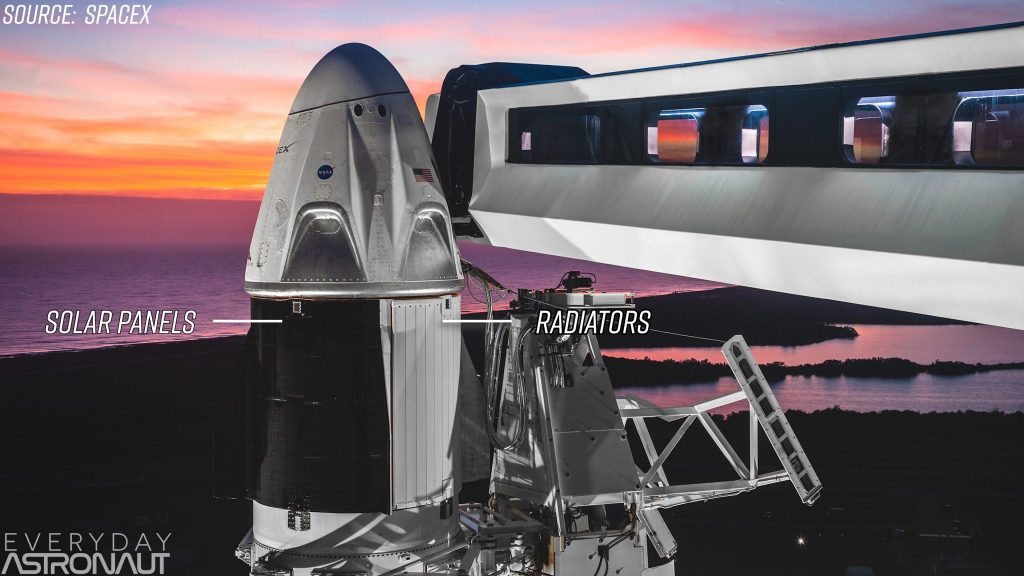
Part of this design freeze also required the use of a new Composite Overwrapped Pressure Vessel or COPV. A COPV failure was the root cause of the AMOS-6 anomaly and COPV strut was the cause of the CRS-7 failure. SpaceX started flying a newly designed COPV at the end of 2018. This is a bit unusual that NASA required a design freeze though, considering NASA has considered flying humans on the 2nd launch of SLS, or even more crazy, there have been talks of the first flight having people onboard! But SpaceX is known to make changes, all the time, in the constant pursuit of improvement, so I think a safer, more conservative approach is a good idea when human lives are involved.
The Falcon 9’s flight profile with crew also had to be altered compared to cargo to ensure the safest profile in case of an abort. Due to the shallower, flatter profile, it means the first stage booster of the Falcon 9 will not do a return to launch site landing and will have to land down range on the drone ship.
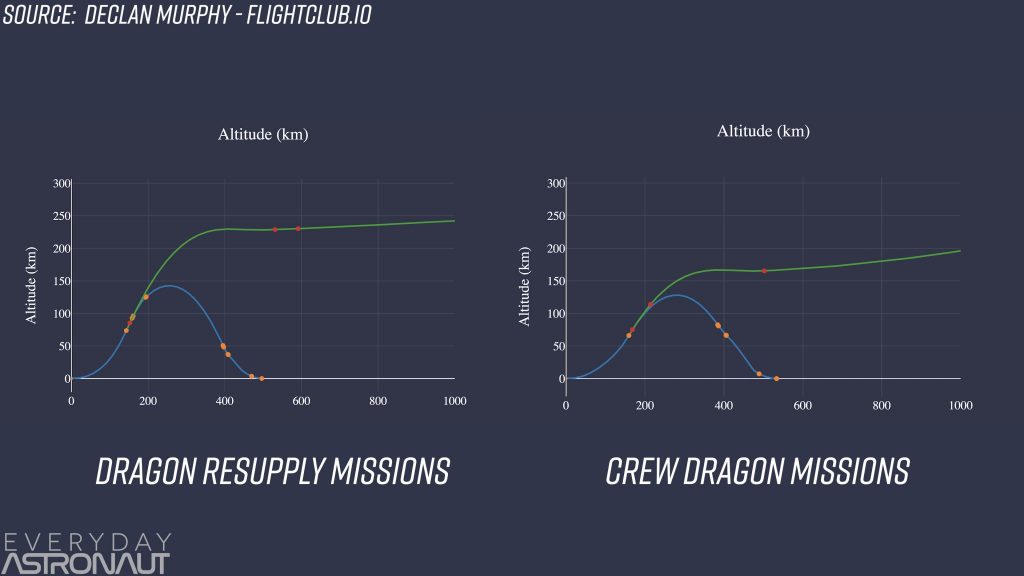
The upperstage of the Falcon 9 uses the Merlin 1D Vacuum engine which is extremely powerful, but not very efficient. It will have no problem maintaining a shallow profile.
Crew will climb on top of a Block 5 Falcon 9 poised at LC-39A at Kennedy Space Center in Florida. I have to say, not that it’s a contest, but SpaceX does have the coolest launch pad ever. After all, this is the same launch pad that humans took off from to go to the moon! Crew will go up the Fixed Service Structure that is a relic from the Space Shuttle era, although SpaceX has done a lot of work to remove the rotating service structure, repaint the tower, add cladding and attach their mobile access arm.
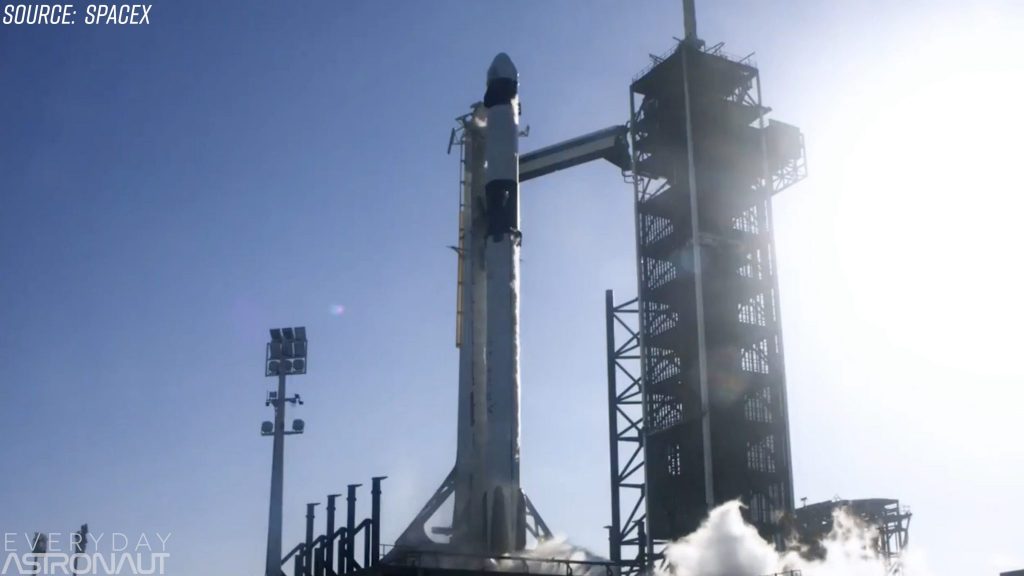
One thing that SpaceX will be doing that’s completely new in the world of human spaceflight and actually took some convincing to make NASA consider it a valid option is a load and go fueling procedure. Since SpaceX uses super chilled propellants, they need to load them into the vehicle as late as possible so they don’t warm up and boil off before the vehicle takes off. SpaceX actually continues to fuel the rocket up until just 3 minutes before lift off. Since 3 minutes isn’t nearly enough time to get up the tower and strap into the Dragon Capsule, the crew will actually enter before propellant load and will remain onboard while the vehicle is fueled up.
While I understand how this is different, I actually feel like it’s a safe move. This means the ground crew and astronauts never need to approach a fully loaded vehicle on the pad. Once fuel starts flowing, the crew is actually in the safest place imaginable, a tightly sealed pressure vessel armed with a powerful abort system. So despite the process of fueling up being potentially risky, the crew is in a very safe place.
Can you imagine, this will be the first time in history a human will hear the sounds cryogenic fuel flowing into the vehicle. They’ll hear all the creaks and strains of the vehicle as it comes to life. That will be wild!
Another fun fact is the crew will arrive to the launch site in Tesla Model Xs…. Of course! Man, SpaceX will be putting on a new show for sure.
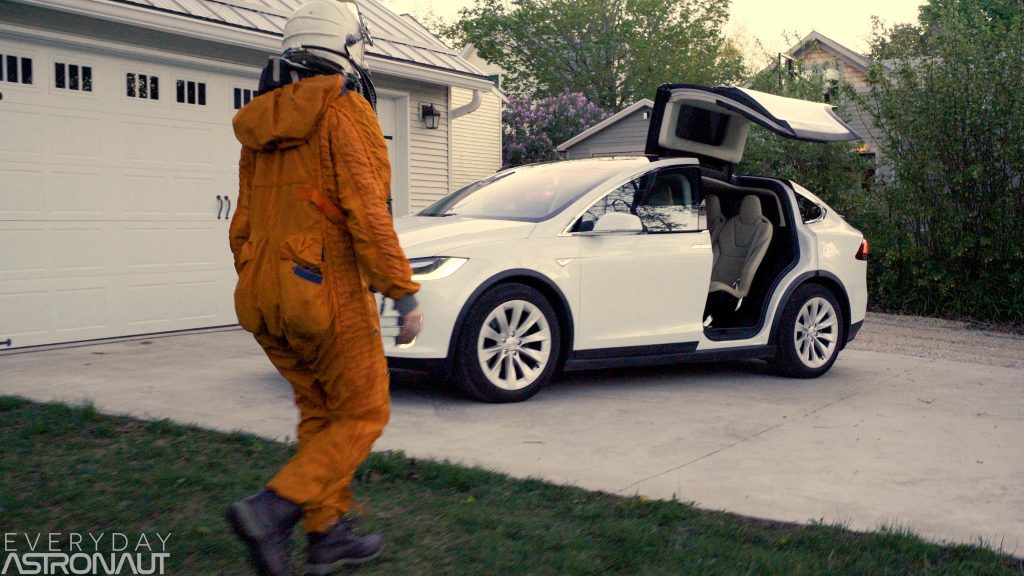
Lastly, before we get onto the direct comparisons, did you know both launch pads feature an amusement park ride… well not quite, but each pad does have an emergency zipline capable of evacuating astronauts and ground crew in a hurry in the unlikely event of say a leak or a fire. While I’m sure there’s limited use cases when these would be useful, it does look like it’d be pretty fun, assuming you’re not being chased by a fireball.

OK wow, enough of the rundown, it’s time to compare these vehicles side by side and see how these new vehicles compare to Soyuz and the Space Shuttle.
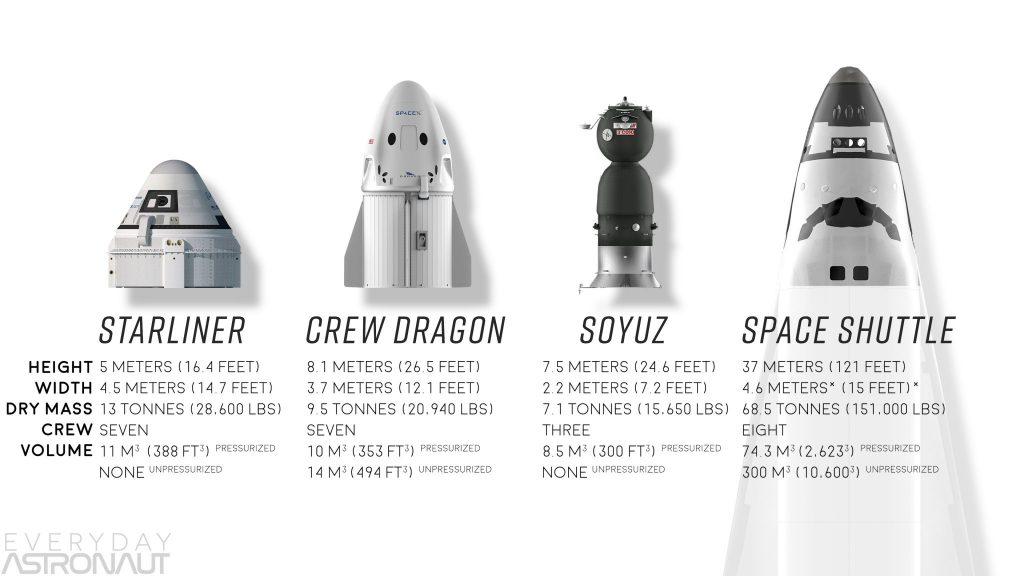
So first off, let’s just line these up side by side and compare their sizes. Yeah, uh the space shuttle orbiter clearly dwarfs these vehicles in size, that thing is huge! And because of its immense size, we’re going to focus in on the crew module portion of the shuttle so we can see the other of the vehicles. But don’t forget about the rest of it, we’ll still be talking about the system as a whole since the aft end is its service module and is similar in nature to the trunk of the Dragon Capsule, just way way bigger. But notice how much bigger the Starliner and Dragon are compared to the Soyuz capsule!

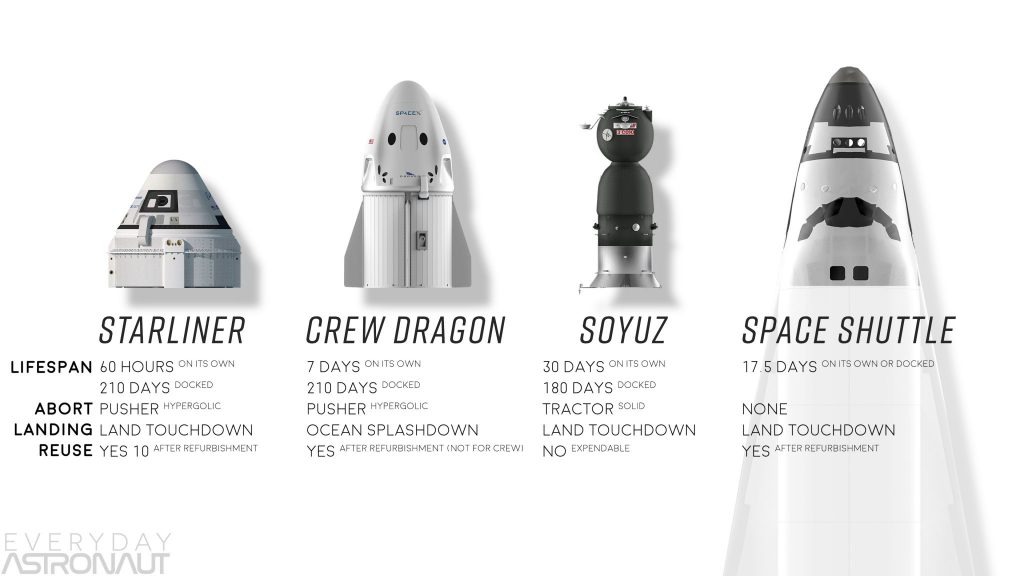
While we have these rockets pulled up, I think it’s important we take a note on their reliability. We’re going to ignore partial failures and only talk about mission success, in which case the Atlas V really comes up on top, at 100% success in its 79 flights, the Falcon 9 has had 69 missions and has had two failures one happening before the launch occurred, giving it a 97.1% success rate, the Soyuz is complicated because it’s been flying since the 60’s in some form or another, so in total it’s 996 out of 1028 for a 96.9%, but it’s the newest variant, the FG has only had one failure out of 66 making it 98.5% successful, and the shuttle had two failures out of 135 launches also making it 98.5% successful. It should also be noted that thanks to a robust abort system, the one failure of the Soyuz FG rocket led to no loss of life.
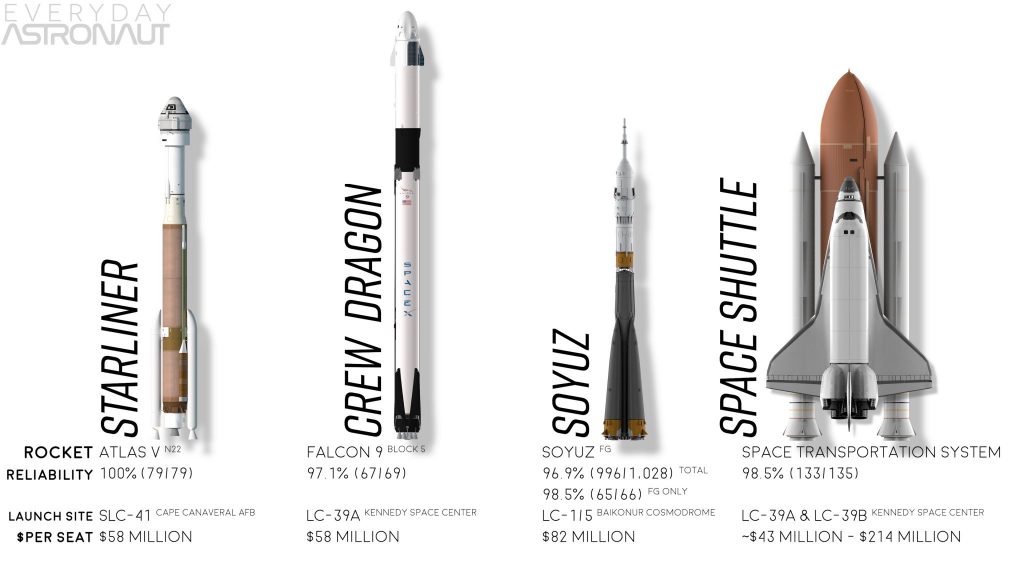
And another quick note, this time about the use of solid rocket boosters. A solid rocket booster led to the loss of the Challenger vehicle, but that’s not to say solids on their own are inherently dangerous. The mixture of solid rocket boosters and a lack of an mechanical abort system is what was dangerous. We’ve learned a lot since the Space Shuttle and the Atlas V’s use of SRBs is considered very safe… and due to the fact that the Starliner does have an abort system if there was a failure, the crew would be able to get away from the rocket… so we really shouldn’t compared the Atlas’ use of SRBs to the space shuttle’s use of SRBs.
And lastly, we’re going to talk about price per seat… and this one has a pretty big asterisk. Both Starliner and Crew Dragon have a price tag of $58 million per seat, the Soyuz Capsule is now up to $82 million per seat, and the Shuttle.. Well… this is a hard one. On paper, the shuttle would cost around $214 million per seat. BUT the space shuttle did a lot more than just take a crew up, it often would carry an additional payload of a dozen tonnes or more. So maybe it’s fair to take that $214 million dollars per seat per launch and then take 80% off because 80% of the volume of the vehicle was dedicated to cargo. But maybe that’s not fair, so let’s just say somewhere between $43 million and $214 million.
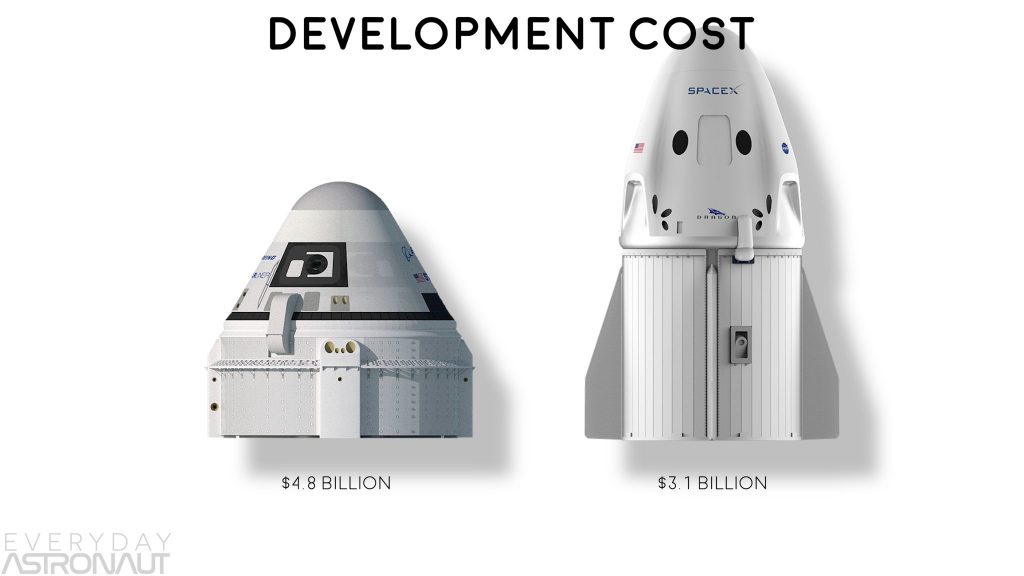
The last thing I want to mention, but only for the Starliner and Crew Dragon is their cost of development. The Starliner has received $4.8 billion in total for development and the first round of launches, while SpaceX received 3.1 billion. This includes 2 demo launches and 6 operational flights from each company.
Now I really don’t want to go down a spitting match of why they received such different amounts, but it likely had to do with each companies proposal. SpaceX likely quoted less initially. Perhaps after SpaceX flies a few dozen astronauts, they can charge a little more for increased confidence from NASA… kind of like how they were able to increase the price of the cargo resupply missions once they proved to be reliable and after they gained a better sense of the costs of running the program.
So when it’s all said and done, here’s my opinion. First off, I could not be more excited to see an awesome pair of exciting new rides to space. It’s about time. As solid and reliable as the Soyuz has been, it’s about time humans have some other, newer, and more comfortable options.
As far as each system goes, I’ve got my opinions and I’ll keep them short, because I already know the comment section will have plenty of opinions to go around. The Starliner is an awesome spaceship. It’s very well thought out, and you can tell, human safety is very much on the top of mind for both Boeing and ULA.
I’m glad to see them landing on land, I think that’ll be a cool thing to see happen, and I’m happy the Atlas will get to carry humans again for the first time since Faith 7 launched with a Mercury-Atlas in 1963!!!
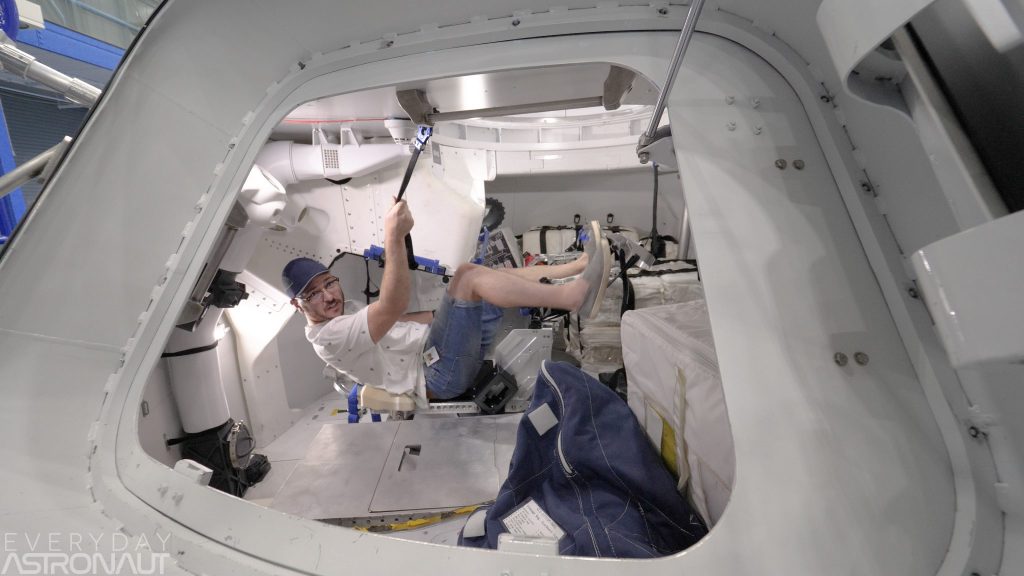
And as advanced as the Starliner is, I do wish they had gone a few steps more progressive. It feels like the spaceship is a little conservative, and you can tell they didn’t want to take any design risks or push any boundaries. Unfortunately, when I got to sit in it, it just feels a little stale and cold. However, aesthetics and ergonomics are a very very minor part of the equation when you’re putting humans in space. So, now we come to SpaceX’s Crew Dragon Capsule.
There is no arguing that SpaceX made the better looking, cutting edge and down right sexy spaceship. It truly is stunning. And quite frankly, the radical departure from the norm really seems to have been pulled off brilliantly. Just look at how easy it is to get into this thing compared to the Starliner.
And I have no doubt the Crew Dragon capsule didn’t cut any corners in safety, well considering they have had to answer to NASA on every single millimeter of the thing… so when it comes to pure cool factor, I’m going to have to give the leg up to SpaceX. But having spoken to some people who have used the touchscreens, we’re talking about hardcore pilots here, they have voiced missing a more traditional control scheme. Saying it does feel a bit like flying an iPad.
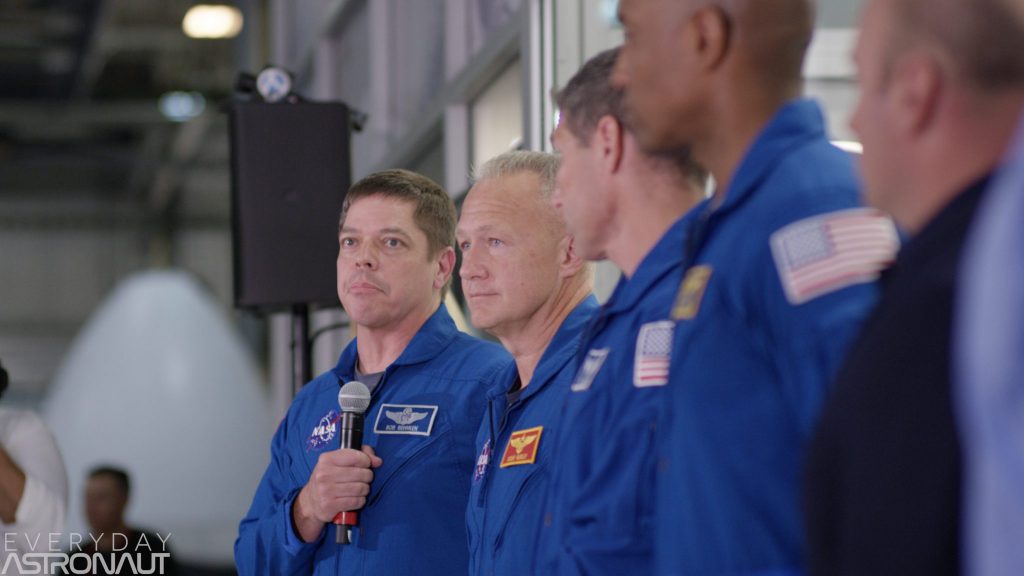
But lastly, seeing a Falcon 9 land after delivering crew to the ISS will be a nice cherry on top. And although we won’t see it land back at Kennedy Space Center, I never get tired of seeing a Falcon 9 land.
So no matter how you cut it, you can’t go wrong. NASA hired two incredible companies to come up with some truly exciting new rides to space. NASA should be proud of this new program. It’s saved them money and now offers a variety of options, offering an overlap and redundancy in humanities access to space.
And although this video was intended to highlight the commercial crew program, to be perfectly honest, I wound up really appreciating the space shuttle more after diving into this. That thing was really something special. Yes, it had its flaws, and it didn’t quite live up to the hype of making spaceflight cheaper or safer, but boy oh boy did it have some unmatched capabilities!
So great job NASA, Boeing and SpaceX! I honestly couldn’t be more excited for this new chapter of Spaceflight. And don’t you all worry, I will be doing my best to bring it all to you!
I’m planning to try and make it down to all demo missions to cover them live, in person! If you want to help contribute and ensure I can bring you the best coverage possible, consider becoming a Patreon supporter by visiting http://Patreon.com/everydayastronaut where you’ll also gain exclusive access to behind the scenes content and exclusive livestreams.






Tim, I know your videos before 100k subscribers. I love it and I want you to know my story. I emailed it to u and I want you to see it
Very interesting post. I get that the Atlas V’s SRBs are much, much safer than the space shuttle’s (no o-rings for one), but it still does bring a bit of trepidation. At least they have a viable abort system (compared to the shuttle). I remember hearing that the Ares I had a study by the Air Force that said something about the motors’ exhaust burning the parachutes, it that not a problem?
You’re right though, the Dragon 2 is downright sexy. Maybe I can now claim KSP does does allow me to simulate the actual thing in a Dragon 😀
It’ll be interesting to see a ISS crew of 10-13!
And Dragon2 has a toilet. Thanks Suni for mentioning that. At the top docking port, with a curtain for privacy.
Boeing’s toilet facilities? Unknown, but a poop bag is awkward, sitting on the bench of a seat.
Dear Mr. Tim Dodd:
Outstanding space educator and some “tv host” (kidding)! It feels so well to share rocket launches live in your fun and knowledgeable company ! (at home no one cares but me about the space industry…) But beyond the YouTube activity your webpage quality is something else! such great content and lots of words and data beyond the great visual aid (being 59 yrs, old makes me I suppose old fashion or old school…)
Congratulations to you and your staff and partners!!!
Always in debt to you and in gratitude!
Best wishes from Patagonia!
Willy Klein.
Great show as always. IMHO I think you should have had the Orion spacecraft instead of the Shuttle.
no I have to disagree because the Orion will not go to the issei’s, all the other space crafts do, the Orion will not fit in that comparison.
What a outstanding article.
Thank you very much!
I love your enthusiasm Tim. Please understand this is only intended to be a constructive correction to you encyclopedia like knowledge of all things space flight.
This statement needs correction. “Can you imagine, this will be the first time in history a human will hear the sounds cryogenic fuel flowing into the vehicle. They’ll hear all the creaks and strains of the vehicle as it comes to life. That will be wild!”
In John Glenn’s own words as he sat aboard FRIENDSHIP 7, February 20, 1962 ( Simon & Schuster “WE SEVEN“ )
“I could hear the pipes whining and crackling below me as the liquid oxygen flowed into the booster tanks, and I could hear a vibrant hissing noise as the tanks were supercooled by the cold LOX.”
And from the NASA.gov website MA-6 Launch report.
https://www.nasa.gov/mission_pages/mercury/missions/friendship7.html
T-120 minutes Prepared for boarding
T-90 minutes Hatch put into place
T-45 minutes 15 minute hold required to add fuel
T-35 minutes Filling of liquid-oxygen tanks begins
FYI, I was 16 years old on that date. Also wonder why NASA was so opposed the SpaceX load and go process. Of course the Space Race was full on then and the Atlas ICBM was the only launch vehicle that could do the job.
Thank you for this good article. You did a great job. Just some leftover questions:
– the cost per seat is calculated with 4 seats used of all seats used?
– the cost per seat range of space shuttle was a great idea, why not using the same range for all vehicles, since they have a payload capacity?
– in my head is something from Virgin Galactic with wings, that also should fly to iss, but it is not suitable for crew so far, is it?
– has Blue Origin something comparable?
I use your attention for thanking you. You’re doing a great job. Much love from Germany.
why is cost per seat in crew dragon larger than launch cost of falcon 9
crewdragon awesome, starliner: recycled apollo command module, SpaceX FTW!
As I don’t inherently disagree with what you stated, I think you’re taking SpaceX’s side a little too much. Don’t get me wrong, I LOVE SpaceX relative to other companies, I mean everything that they do captures the attention of the public. But, what matters is getting crew from Earth, to the ISS, and back safely. On that count, I have total faith that BOTH SpaceX and Boeing did their research. I think that the public (myself included) severely underestimates NASA’s involvement, and using their decades of experience to help make sure that all of the astronauts stay safe. You Even heard Elon say in the press conference that (paraphrased) “NASA and SpaceX practically co-designed the Dragon.” But yes, Crew Dragon looks SO GOOD. Everything about it looks so good. First, driving in a Tesla Model X to the beautiful historic launch pad 39-A. Then, you walk on the futuristic crew access arm, onto the Falcon 9 Block 5 (easily the 2nd best looking rocket ever, behind Falcon Heavy). You are in easily the most modern and sleek capsule ever made. The whole flight is to marvel at, the landing of the booster, the deploy of dragon.
As usual, great video, Tim! I thank you for putting in the time to make these high quality video and articles for us!
IT IS CRIMINAL THAT NASA is paying 2BILLION MORE to the Political Lobbyist Boeing Lockheed’s crew capsule than to the SpaceX Crew Capsule, given Space X’s product is way more comfortable and capable and safer. Look in trouble with Space Station they can keep crew safe and comfy for a Week, while the Boeing product is harsh and can only keep crew alive for Hours not a Week!
Missing characters, I think, talking about the lattice structures on Starliner: “The lattice structure helps diffuse the airflow over the vehicle, helping to make sure there are no shock waves or any inadvertent pressure areas on the lower portion of the vehicle on the scent.”
Probably ascent, or descent. I will avoid fart jokes here!
Nice article.
I think that both the Boeing Starliner and SpaceX Dragon are pathetic in comparison to the Space Shuttle. The US should be ashamed of itself for backing out of manned spaceflight when it did. Incidentally, liquid hydrogen propellant is not at all new. It was used for two stages of the Saturn V which is what NASA used to send people to the moon. So “super cooled fuel” is very much ho-hum.
I am totally unimpressed with the electronics on either the Starliner or the Dragon. Why did the article even talk about it? It is boring. Off the shelf electronics is generations beyond what was available during the moon program and when the Space Shuttle was designed. My one bit of curiosity is whether NASA is allowing commercial electronics or is requiring space certified components like in the old days. (I was one of the designers of the Multi-Mission LEO modular satellite. Specifically the CU in the STACC system. We used bipolar electronics for radiation hardness.)
Can’t believe we are fundamentally back to technology used in Apollo 7 in 1969 .
NASA choose not to go with the Dream chaser mini shuttle system, which was a fantastic project ;now destined for only cargo flights. This would have been a far more advanced 21st century system, without all the ridiculous paraphernalia of recovery
I know this is an older article – but its still super informative, so thank you.
The only point I would argue is the Starliner reusability. Yes – they can refurbish and reuse the capsule, but both SpaceX and Starliner are using disposable ‘Service Modules’ (or in SpaceX Parlance, ‘Trunk’) . Difference being, the Starliner SM houses a very ‘Important’ (read – expensive) stuff – IE the Abort Engines, RCS thrusters, and Fuel. The SpaceX Trunk is essentially that – Storage space. Both house Solar generation, and radiators, But the ‘expense’ of the disposed Boeing SM is much greater that of SpaceX, as Dragon is seemingly ‘fully integrated’. Essentially, the Starliner is a car without an enginer, where the Dragon is a whole car.
Now, SpaceX will refurbish the capsule for Cargo flights – and thats something. We won’t know what this looks like until after a successful crewed mission of course, and at least its ‘something’ reused. But its not reusable for Crew missions. and thats kind of a bummer.
Basically:
Starliner is a family minivan, that you drive to its destination, remove the engine, tow it back home, replace the tires, brakes, and engine with new components, and THEN can drive again.
Dragon is the same minivan, that your drive to its destination, and then drive home, but once you get home, you can no longer use it as a family minivan, but only as a cargo van.
So – Starliner is reusable, But basically only as a shell. Where Dragon is resuable, but for only 50% of its purpose. Both leave more to be desired, but I have to believe that Dragon is at least more economical (I could be wrong).
This just makes me yearn more for Starship, really. And I think Musk is making the right call – stop making small improvements on current tech, and use the time and resources on driving R&D on Starship. Boeing has no ‘Starship’ like ambitions, and that is a big negative to me in this game.
Where does the starliner land during a Florida abort?
I would like to see the Dream Chaser carrying people in the future.
Hello Tim. I have an idea and for all I know SpaceX may have already done it?
SpaceX & SpaceNurds have many cameras capturing great video. SpaceX have flood-lights for security & safety & data gathering. So careful camera positioning is reqd for optimum quality. If the lights get switched on mid test then lots of video suffers.
IF SpacsX were to put a polorising filter in front of all the flood-lights, (All at the same angle of polorisation of course) then the SpaceX security cameras and Test facility data gathering cameras and the spectators cameras would all be capable of better quality video (if the cameras were all fitted with 90 degree polorising filters.
Perhaps an Internet poll of people visiting SpaceX with cameras would be useful to give SpaceX the inclination to install such filters? Perhaps SpaceX could sell suitable filters, some that can be attached to the lens (Gaffatape etc) (for tripod work etc and some like a window – these big panels could be mounted on a dedicated tripod to get the angle correct and allow the camera user the freedom to pan & yaw their handheld or seperatelymounted cameras – ideal for flights and other site motions. Because a filter on a lens will only be optimum at certain viewing angles of course.
Thanks.